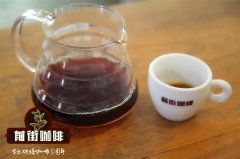Coffee three swordsmen's Tanzanian Coffee introduction what are the famous brands of Tanzanian coffee

Professional coffee knowledge exchange more coffee bean information please follow the coffee workshop (Wechat official account cafe_style)
Coffee first became a cash crop in Tanzania (formerly Tanganyika) during German colonial rule. In 1911, the colonial government ordered the planting of Arabica coffee trees in the Bukoba producing area, but the planting method was so different from the traditional practice of the Haya that the Haya were reluctant to replace food crops with coffee trees.
Even so, coffee production in this area has increased. Other parts of the country were less familiar with coffee cultivation, so there was less opposition, and the Chagga tribe, who lived around the Kilimanjaro Mountains, changed their crops to coffee after the Germans banned the slave trade.
After the first World War, the management of the district was transferred to the British. They planted more than 10 million coffee seedlings in Bukoba, but they also clashed with the Hayans, usually uprooting them. Therefore, compared with Chagga district, the coffee industry here has not developed significantly.
The first common cooperative was established in 1925 as Kilimanjaro Native Planters'Association (KNRA). This is the first of several co-operatives, so its producers have more freedom to sell directly to London for higher prices.
The grading of raw coffee beans in Tanzania is first rated according to the altitude of the coffee producing areas, the quality of raw coffee beans in the same higher altitude areas is higher, and then the final grading is carried out according to the number of raw coffee beans at the same altitude. In general, Tanzania is named after AA, A, B, etc.
AA level: 18 items account for at least 90% of the total, 17 items account for 8-10%, and 15 items account for 2% at most.
Class A: 15ram 6 items account for at least 90% of the total; 14 items account for up to 2%.
Class B: 15thumb 6 items account for at least 90% of the whole.
Class C: 14 mesh accounts for at least 90% of the total; 13 mesh up to 10%.
PB: 14 items account for at least 90% of the total; floating beans up to 5%.
AF class: 17 items account for at least 90% of the total; 15 ppm 6 mesh at most 8-10%; 14 mesh at most 2%.
TT grade: 15ram 6 items account for at least 90% of the whole, 14 items up to 10%.
Class E: 18 mesh accounts for at least 90% of the total; a maximum of 10% is allowed to be less than 18 mesh, but not less than 15 mesh.
Coffee beans from Africa and Tanzania are of extraordinary quality and are produced in the Mohi district near Mount Kilimanjaro. The mountains with a height of 3,000 to 6,000 feet are the most suitable areas for growing coffee. Fertile volcanic ash gives the coffee here a strong texture and soft acidity. It exudes delicate aromas and contains aromas of wine and fruit, making people taste endless aftertaste. After drinking Kilimanjaro coffee, I always feel a soft and mellow earthy smell around my mouth. Coffee gourmets often use words such as "wild" or "wild" to describe it. It can be said that pure Kilimanjaro coffee is "the most African coffee".
Kilimanjaro AA is the highest grade of beans, its grains are full, pure flavor, rich and refreshing, all aspects of quality are good. It is usually milder acidic than Kenyan coffee and evenly stimulates the taste buds in the middle and sides of the back of the tongue, feeling a bit like tomato or soda. After moderate or more moderate baking, it has a strong aroma, then grind it into a fine powder, soak it in a pot of boiling water, and invite friends to sit around and taste it.
The famous coffee brands in Tanzania are Africafe, Tanica Cafe, Kilimanjaro and so on, and their quality is much better than the Nestle coffee we often drink. Tanzanian coffee has long been loved by Europeans and has joined the ranks of famous products. Europeans give Tanzanian coffee the nickname "coffee gentleman", and Chinese coffee connoisseurs call it the "coffee swordsman" with the mocha of the "King of Coffee" and the "Lady of Coffee".
END
Important Notice :
前街咖啡 FrontStreet Coffee has moved to new addredd:
FrontStreet Coffee Address: 315,Donghua East Road,GuangZhou
Tel:020 38364473
- Prev

Honduran coffee has a rich and mellow taste, no astringency, no acidity and high aroma.
For more information about coffee beans, please follow the Coffee Workshop (official Wechat account cafe_style) Honduras is located in the north of Central America, bordered by the Caribbean Sea to the north, the Gulf of Fonseca in the Pacific Ocean to the south, Nicaragua and El Salvador to the east and south, and Guatemala to the west, mostly by mountains and plateaus. It covers an area of 112492 square kilometers and the coastline is about 1033 kilometers long.
- Next

What are the flavor characteristics of Yega Sheffield coffee?
Professional coffee knowledge exchange more coffee bean information please follow the coffee workshop (Wechat official account cafe_style) the ancient countries of the African continent, Ethiopia is the hometown of Arabica coffee, it is in the forests of the Kaffa region that you can see wild Arabica coffee. Coffee is the equivalent of the country's currency in Ethiopia, almost all the rich
Related
- Does Rose Summer choose Blue, Green or Red? Detailed explanation of Rose Summer Coffee plots and Classification in Panamanian Jade Manor
- What is the difference between the origin, producing area, processing plant, cooperative and manor of coffee beans?
- How fine does the espresso powder fit? how to grind the espresso?
- Sca coffee roasting degree color card coffee roasting degree 8 roasting color values what do you mean?
- The practice of lattes: how to make lattes at home
- Introduction to Indonesian Fine Coffee beans-- Java Coffee producing area of Indonesian Arabica Coffee
- How much will the flavor of light and medium roasted rose summer be expressed? What baking level is rose summer suitable for?
- Introduction to the characteristics of washing, sun-drying or wet-planing coffee commonly used in Mantenin, Indonesia
- Price characteristics of Arabica Coffee Bean Starbucks introduction to Manning Coffee Bean Taste producing area Variety Manor
- What is the authentic Yega flavor? What are the flavor characteristics of the really excellent Yejasuffi coffee beans?

